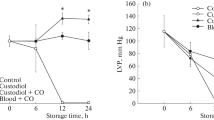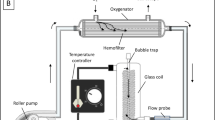Summary
In search for new techniques of renal preservation, kidneys were persufflatedin situ with gaseous O2 at a pressure of 90–100 mm Hg via their vascular system (orthograde aerobic ischemia). The results on post-ischemic function and blood flow, and on the changes in the renal tissue levels of the adenine nucleotides were compared to those obtained from kidneys ischemically stored without additional measures (anaerobic ischemia). The kidneys were stored for 4 hrs at 6°C. A contralateral nephrectomy was performed before the preservation period.
All dogs subjected to renal anaerobic ischemia survived. After orthograde aerobic ischemia, 3 out of 4 dogs died from uremia within 8 days, 1 animal survived. Although the aerobic ischemic preservation resulted in the maintenance of a metabolic status characteristic for aerobiosis, post-ischemic renal function recovered too slowly and insufficiently on the average. Renal blood flow was within normal ranges after anaerobic ischemia, it was reduced to about one third of this after orthograde aerobic ischemia.
Similar content being viewed by others
References
Arnold, G.: Die Verlängerung der nutzbaren Ischämiedauer des Herzens durch Erhöhung des äußeren O2-Partialdruckes und Persufflation der Coronargefäße mit gasförmigem Sauerstoff. Langenbecks Arch. klin. Chir.319, 641 (1967).
Arnold, G., Müller-Ruchholtz, E. R., Lochner, W.: Die Persufflation der Koronargefäße mit gasförmigem Sauerstoff zur Verlängerung der Ischämiedauer des Herzens. Ärztl. Forsch.22, 257 (1968).
Bihler, J., Gabel, L. P., Dresel, P. E.: Studies on the oxygen perfused kitten heart. 23. International Congress of Physiological Sciences, Proceedings of the International Union of Physiological Sciences, p. 138. Tokyo 1965.
Bunzl, A., Burgen, A. S. V., Burns, B. D., Pedley, N., Terroux, K. G.: Methods for studying the reflex activity of the frog's spinal cord. Brit. J. Pharmacol.9, 229 (1954).
Burns, B. D., Robson, J. G., Smith, G. K.: The survival of mammalien tissues perfused with intravascular gas mixtures of oxygen and carbon dioxide. Canad. J. Biochem.36, 499 (1958).
Camishion, R. C., Davies, A. C., Tokunaga, K., Solit, R. W.: Retrograde perfusion of the coronary arteries with gaseous oxygen during cardiopulmonary bypass. Surgery59, 145 (1966).
Castrup, H. J., Witte, J., Berger, M., Denecke, H., Isselhard, W.: Renal histology during and after preservation by anaerobic and aerobic ischemia. In preparation.
Gabel, L. P., Bihler, J., Dresel, P. E.: Contractility, metabolism and pharmacological reactions of isolated, gas-perfused cat hearts. Circulat. Res.19, 891 (1966).
Isselhard, W., Berger, M., Denecke, H., Witte, J., Fischer, J. H., Molzberger, H.: Metabolism of canine kidneys in anaerobic ischemia and in aerobic ischemia by orthograde and retrograde persufflation with gaseous oxygen. Pflügers Arch.337, 87 (1972).
Isselhard, W., Merguet, H.: Metabolite des Glykolyse-Cyclus und des Adenylsäure-Phosphokreatin-Systems im schlagenden und durchbluteten Warmblüterherz unter verschiedenen Versuchsbedingungen. Pflügers Arch. ges. Physiol.276, 211 (1962).
Lannon, S. G., Tukaram, K. T., Oliver, J. A., Mac Kinnon, K. J., Dossetor, J. B.: Preservation of kidneys assessed by a biochemical parameter. Surg. Gynec. Obstet.124, 999 (1967).
Lochner, W., Arnold, G., Müller-Ruchholtz, E. R.: Metabolism of the artificially arrested heart and of the gas-perfused heart. Amer. J. Cardiol.22, 299 (1968).
Magnus, R.: Die Tätigkeit des überlebenden Säugetierherzens bei Durchströmung mit Gasen. Naunyn-Schmiedebergs Arch. exp. Path. Pharmak.47, 200 (1902).
Müller-Ruchholtz, E. R., Arnold, G., Miessner, E., Lochner, W.: Metabolitgehalt und Herzarbeit bei Durchströmung der Coronargefäße mit gasförmigen und flüssigen Medien. Pflügers Arch. ges. Physiol.294, R 4 (1967).
Sabiston, D. C., Talbert, J. L., Riley, L. H., Blalock, A.: Maintenance of the heart beat by perfusion of the coronary circulation with gaseous oxygen. Ann. Surg.150, 361 (1959).
Talbert, J. L., Rhey, L. H., Sabiston, D. C., Blalock, A.: An evaluation of gaseous oxygen perfusion as a method for maintaining renal viability during periods of complete ischemia. Surg. Gynec. Obstet.112, 593 (1961).
Talbert, J. L., Rily, L. H., Sabiston, B. C., Blalock, A.: Retrograde perfusion of the coronary sinus with gaseous oxygen. Amer. J. Surg.26, 189 (1960).
Author information
Authors and Affiliations
Additional information
Dedicated to Prof. Dr. Dr. R. Zenker for his 70th birthday.
Supported by a grant from the Deutsche Forschungsgemeinschaft in the Sonderforschungsbereich 68.
Rights and permissions
About this article
Cite this article
Isselhard, W., Denecke, H., Stelter, W. et al. Function and metabolism of canine kidneys after aerobic ischemia by orthograde persufflation with gaseous oxygen. Res. Exp. Med. 159, 288–297 (1973). https://doi.org/10.1007/BF01851603
Received:
Issue Date:
DOI: https://doi.org/10.1007/BF01851603




